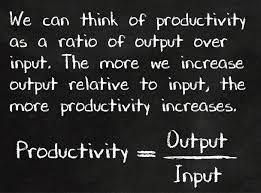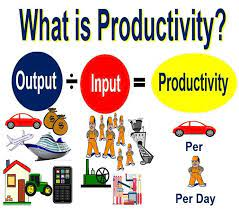Productivity: What It Is and Why It Matters
As a business owner, manager, or employee, you have probably heard the term productivity thrown around a lot. But what is the productivity paradox? What exactly what is productivity doing, and why is it important? This article will delve into what productivity means and its significance for business leaders in the workplace.
Defining Productivity

Productivity refers to the efficiency of a person, team, or organization producing goods or services. It is the gross value of output generated about the amount of input required to make it, such as time, money, physical capital, raw materials, and resources. In other words, productivity measures how much value is created per unit of effort.
Why Is Productivity Important?
Productivity is essential for several reasons. Firstly, it is a crucial driver of economic growth. As productivity increases, more goods and services can be produced with the same resources, leading to increased output and higher living standards. Secondly, productivity is closely linked to profitability. As a result, more productive companies can generate more revenue and profits while controlling costs. Thirdly, improved workforce productivity can improve employee satisfaction and engagement. When employees are effective, they feel a sense of accomplishment and fulfillment from productive work, leading to higher morale and job satisfaction.
Factors Affecting Productivity
Several factors can impact productivity, including:
- Technology – Using technology, such as software, automation, and artificial intelligence, can significantly boost productivity by streamlining processes and reducing the need for manual labor.
- Work Environment – A positive workplace promotes productivity through collaboration, communication, and employee engagement.
- Training and Development – Providing employees with the necessary training and development opportunities can enhance their skills and knowledge, leading to higher productivity.
- Time Management – Effective time management practices can help employees prioritize tasks and minimize distractions, increasing productivity.
- Motivation and Incentives – Motivating employees through recognition, rewards, and incentives can encourage them to be more productive and engaged.
How to Improve Productivity
Improving employee productivity requires a combination of strategies and techniques tailored to your workforce skills and the organization’s specific needs. Some practical ways to enhance workforce productivity include:
- Streamlining Processes – Analyzing and optimizing workflows can eliminate unnecessary steps and reduce bottlenecks, leading to faster and more efficient operations.
- Automation – Automating repetitive tasks can save time for more important activities, such as strategic planning and decision-making.
- Training and Development – Providing employees with the necessary training and development opportunities can enhance their skills and knowledge, leading to higher productivity.
- Performance Monitoring – Regularly monitoring and measuring performance can identify areas for improvement and help employees stay on track toward their goals.
- Employee Engagement – Engaging employees through communication, collaboration, and recognition can foster a positive work environment and promote productivity.
In summary, productivity is a crucial concept in the workplace that can drive economic growth, increase profitability, and improve employee satisfaction. Organizations can achieve tremendous success in technological improvements in economic performance, labor productivity examples, and competitiveness in their respective industries by understanding the factors that impact productivity and implementing strategies to enhance it.

Measuring Productivity
Measuring a country’s productivity can be challenging, depending on the specific industry and the produced output gross domestic product type. However, several standard metrics can be used to assess a country or company’s production process and productivity, including:
- Labor Productivity – This measures the output per hour of labor and is commonly used in manufacturing and construction industries.
- Total Factor Productivity – This measures the efficiency with which all inputs, such as labor, capital, and resources, are used to produce output.
- Multifactor Productivity – This measures the efficiency with which specific inputs, such as labor and capital, are being used to produce output.
- Revenue per Employee – This measures the revenue generated per employee and can be used to evaluate the productivity of service-based businesses.
By using the productivity measures measured, regularly monitoring these material productivity metrics, and analyzing productivity trends further, organizations can identify areas for improvement and implement targeted strategies to enhance productivity.
Tips for Writing Productive Content
As a writer, your goal is to create content that is not only informative but also productive. Here are some tips for personal productivity and writing compelling content:
- Identify your target audience and their needs. This will help you tailor your content to their requirements and create more relevant and valuable content.
- Use clear and concise language. Avoid using jargon or technical terms that may be confusing to your audience. Instead, use simple language that is easy to understand.
- Use bullet points and subheadings to break up long paragraphs and make your content more scannable. This will help your readers quickly find the information they seek and improve the overall user experience.
- Include practical tips and actionable advice. Provide your readers with concrete steps they can take to apply the information you have provided and achieve their goals.
In conclusion, productivity is a vital concept in the workplace that can drive business growth, measure productivity, keep productivity, measure increased profitability factors affect productivity, and improve employee satisfaction.
Organizations can achieve tremendous success and competitiveness in their respective industries by understanding the factors that impact productivity and implementing targeted strategies to enhance it.
As a writer, you can contribute to productivity by creating informative and practical content that helps your readers achieve their goals.

The Importance of Productivity in the Workplace
Productivity is a critical component of any successful business. It refers to the output produced by the production process per unit of input or input units, such as a labor force, physical capital, or resources. High productivity can lead to increased profits, improved employee satisfaction, and a competitive advantage in the marketplace.
In contrast to total factor productivity, low productivity can lead to missed deadlines; low productivity fails less-quality services produced, output, and decreased profitability net sales. Therefore, organizations must understand the factors that impact productivity and implement strategies to enhance it.
Factors that Impact Productivity
Several factors can affect productivity in the workplace, including:
- Technology – The use of technology can significantly improve productivity by automating repetitive tasks, reducing errors, and improving communication.
- Training and Development – Providing employees with ongoing training and development opportunities can enhance their skills and knowledge, leading to increased productivity.
- Workplace Environment – The physical environment can impact productivity by affecting employee morale and motivation. A well-designed workplace that is comfortable and conducive to work can increase productivity.
- Employee Engagement – Engaged employees are more motivated, committed, and productive. Organizations can foster engagement by providing employees with meaningful work, recognition, and opportunities for growth.
- Work-Life Balance – Employees with a good work-life balance are more productive and less likely to experience burnout. Organizations can support work-life balance by offering flexible work arrangements and promoting self-care.
Implementing Strategies to Enhance Productivity
Organizations can implement several strategies to enhance productivity, including:
Streamlining Processes – By simplifying and automating processes, organizations can reduce errors, save time, and increase efficiency.
Setting Realistic Goals – Clear and achievable goals can motivate employees and help them focus on the most critical tasks.
Providing Adequate Resources – Employees with the necessary resources, such as equipment, software, and training, can increase productivity and job satisfaction.
Offering Incentives – Bonuses, promotions, and recognition can motivate employees and increase productivity.
Fostering Collaboration – Collaboration can improve productivity by promoting teamwork, sharing ideas, and reducing duplication of effort.
By implementing these strategies, organizations can enhance their economic productivity and succeed tremendously in the technological development of their respective industries.
Productivity is a critical component of any successful organization. It impacts profitability, employee satisfaction, human capital, productivity, and competitiveness in the marketplace. Organizations can achieve tremendous success in capital productivity and growth by understanding the factors that affect productivity and implementing targeted strategies to enhance it. As a writer, you can contribute to productivity by creating informative and practical content that helps your readers achieve their goals.

The Benefits of Prioritizing Productivity in the Workplace
Productivity is essential for national and productivity growth, economic data, and the success of any business. Prioritizing productivity in the workplace can have several benefits for team productivity, including:
Increased Efficiency – Productive Employees can accomplish more tasks in less time. This can lead to increased efficiency and reduced costs.
Improved Quality – Productive employees are more focused and less likely to make errors. This can lead to improved quality of work and increased customer satisfaction.
Higher Morale – When employees are productive, they are more likely to feel a sense of accomplishment and job satisfaction. This can lead to higher morale and lower turnover rates.
Competitive Advantage – Productivity can give organizations a competitive advantage by allowing them to produce more goods or services in a shorter time, reducing costs and increasing profitability.
Innovation – By focusing on productivity, organizations can free up time and resources to invest in research and development, leading to innovation and growth.
Measuring Productivity
Measuring productivity is essential for organizations to calculate productivity, measure output, track productivity, identify areas for improvement and track progress. Several methods can be used to measure productivity, including:
- Output-Based Measures – These measures track the output produced by employees, such as the number of products manufactured or services provided.
- Input-Based Measures – These measures track the input required to produce a given output, such as the number of hours worked or resources used.
- Quality-Based Measures – These measures track the quality of employee output, such as customer satisfaction ratings or defect rates.
Implementing Productivity Initiatives
To further improve personal productivity and productivity in the workplace, organizations can implement several initiatives to maximize personal productivity elsewhere in the manufacturing company, including:
Time Management – Encouraging employees to prioritize their time and avoid distractions can improve productivity and reduce wasted time.
Employee Training – Providing employees with training and development opportunities can improve their skills and knowledge, increasing productivity.
Performance Management – Regularly reviewing employee performance and providing feedback can help employees identify areas for improvement and increase productivity.
Flexible Work Arrangements – Offering flexible work arrangements, such as telecommuting or flextime, can improve work-life balance and increase productivity.
Technology – Investing in technology, such as automation or collaboration tools, can improve efficiency and communication, increasing productivity.
Prioritizing productivity in the workplace can lead to increased output growth, increased productivity and efficiency, partial productivity, improved quality, more productivity gains higher morale, a competitive advantage, and innovation. In addition, measuring productivity and implementing initiatives to improve it can help organizations achieve their goals and increase their success. As a writer, you can contribute to productivity by providing valuable information and resources that help individuals and organizations improve their productivity.

Maximizing Productivity: Tips for Individuals and Organizations
Improving productivity is essential for individuals and organizations to achieve their goals and maximize their success. Here are some tips to make productivity improvements and help individuals and organizations track their productivity levels and increase their productivity:
Tips for Individuals:
Set Goals – Setting clear and specific goals can help individuals stay focused and motivated.
Prioritize Tasks – Prioritizing tasks based on their importance and urgency can help individuals manage their time more effectively.
Avoid Distractions – Avoiding distractions like social media or unnecessary meetings can help individuals focus on their work.
Take Breaks – Regular breaks can help individuals recharge and maintain their focus and energy levels.
Seek Feedback – Seeking feedback from colleagues or managers can help individuals identify areas for improvement and adjust their work habits.
Tips for Organizations:
Encourage Communication – Encouraging open and frequent communication can improve collaboration and reduce misunderstandings, increasing productivity.
Provide Training – Employees with training and development opportunities can improve their skills and knowledge, increasing productivity.
Offer Incentives – Offering incentives, such as bonuses or recognition programs, can motivate employees and increase their productivity.
Foster a Positive Work Environment – Fostering a positive work environment through team-building activities or employee recognition can increase morale and productivity.
Embrace Technology – Embracing technology, such as automation or collaboration tools, can improve efficiency and communication, increasing productivity.
CoopBusiness is a revolutionary cooperative business-building platform that empowers individuals to become entrepreneurs, business owners, and financially independent.
As a member, you’ll receive top-level business mentorship, access to our proprietary business systems, and the opportunity to access the funds you want to turn your business ideas into reality.